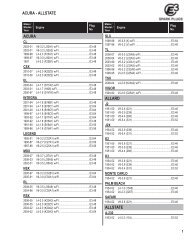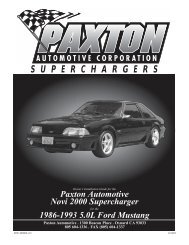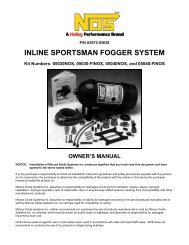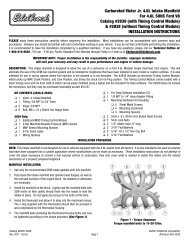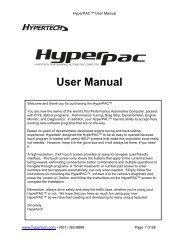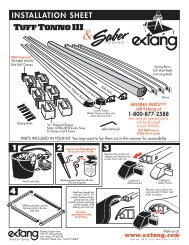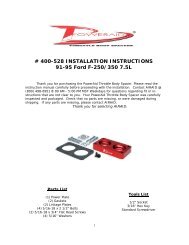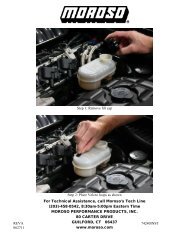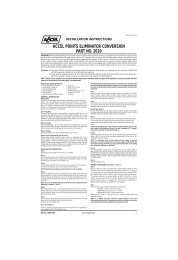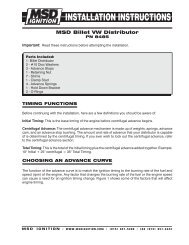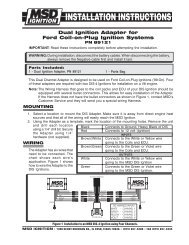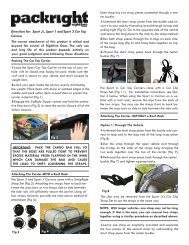Edelbrock 70055 Nitrous System Installation Instructions - Jegs
Edelbrock 70055 Nitrous System Installation Instructions - Jegs
Edelbrock 70055 Nitrous System Installation Instructions - Jegs
You also want an ePaper? Increase the reach of your titles
YUMPU automatically turns print PDFs into web optimized ePapers that Google loves.
1.3 Engine Operation Considerations<br />
When used correctly, nitrous oxide safely elevates cylinder pressures and temperatures while increasing<br />
combustion rate. These characteristics make the engine more sensitive to detonation. To ensure proper<br />
performance, engine and drive line life, the following tips are suggested:<br />
• Adequate Fuel Pressure and Delivery<br />
When designing your fuel system, plan on your pumps and lines flowing at least 0.10 gallons per hour per<br />
horsepower. The testing at <strong>Edelbrock</strong> was conducted with a fuel pressure of 7 to 7.5 psi. Any<br />
variations from this fuel pressure will cause your final air/fuel ratio to change. Consult our Technical<br />
Department for any questions on fuel pressure and its effects on final air/fuel ratios when using nitrous<br />
oxide.<br />
• Victor Jr. Fuel <strong>System</strong> Requirements<br />
When using the Victor Jr. Series Kits, the potential horsepower gains are extremely high. The critical area<br />
for continued success with your nitrous system lies in the fuel system. In the case of the Victor Jr. Series<br />
<strong>Nitrous</strong> <strong>System</strong>s, an auxiliary fuel supply system is a required addition to your nitrous system. A high flow<br />
electric fuel pump and high capacity adjustable fuel pressure regulator are both recommended to ensure<br />
the fuel flow rate is enough to ensure proper system operation. The minimum size we recommend for the<br />
fuel inlet feed line is a -6 (3/8” inch), with a size of -8 (1/2” inch) recommended for the higher horsepower<br />
settings.<br />
• Victor Jr. <strong>System</strong> Monitoring Requirements<br />
Fuel pressure and nitrous pressure gauges are very important. Your fuel pressure must be set properly<br />
and a gauge is the only sure way to monitor system performance. The same is true of the nitrous bottle<br />
pressure. A nitrous pressure gauge is the only way to be ensure that your system calibrations are within<br />
the parameters required of your horsepower settings.<br />
• Fuel Quality<br />
Because <strong>Nitrous</strong> oxide is an oxidizer, fuel selection is critical. Both octane and fuel consistency affect fuel<br />
burn rate. The oxidizer quality of nitrous oxide will accelerate the burn rate, so we recommend a high<br />
quality of gasoline. We also recommend you use the same grade of gasoline every time you use your<br />
nitrous oxide system. This will help maintain the same fuel burn rate every time.<br />
• Cast Pistons<br />
With all nitrous oxide applications, forged pistons are highly recommended. Because of heightened<br />
potential for detonation, cast pistons are more prone to failure and cannot handle horsepower increases<br />
over 125hp. Due to this fact, the Victor Jr. <strong>Nitrous</strong> <strong>System</strong>s require that the engine has forged<br />
pistons. Never initiate your nitrous system before you are at full-load, wide open throttle conditions. Cast<br />
pistons will not be able to survive this kind of stress.<br />
• Engine <strong>System</strong> Upgrades<br />
With all performance modifications, complementary system upgrades will always serve to elevate the<br />
consistency and longevity of an engine, especially when using nitrous oxide as a power adder.<br />
Modifications such as ignition upgrades, free-flowing exhaust, camshafts, cylinder heads, and manifolds<br />
can all add to the performance of a nitrous oxide-injected engine.<br />
Catalog #<strong>70055</strong> & #70056<br />
Brochure No. 63-0060<br />
Page 7 of 26<br />
©2002 <strong>Edelbrock</strong> Corporation<br />
Rev. 3/02



